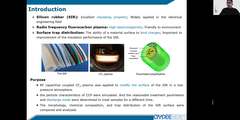Regulation of surface trap distribution on silicone rubber by radio frequency fluorocarbon plasma
ID:199
Submission ID:264 View Protection:ATTENDEE
Updated Time:2021-12-03 10:46:49 Hits:744
Oral Presentation

Start Time:2021-12-16 10:45 (Asia/Shanghai)
Duration:15min
Session:[D] High voltage and insulation technology » [D4] Session 22
Video
No Permission
Presentation File
Tips: The file permissions under this presentation are only for participants. You have not logged in yet and cannot view it temporarily.
Abstract
The surface trap distribution of insulating materials has a significant effect on the electrical resistance along the surface. Therefore, RF capacitive coupled plasma (CCP) was applied to modify the surface of silicone rubber in low-pressure CF4 gas. A one-dimensional fluid model of CCP based COMSOL simulation software was established. The electron temperature, electron number density, and ion density distribution of plasma were analyzed, and the surface treatment parameters of plasma were determined. The surface morphology and chemical structure of samples were observed by scanning electron microscopy (SEM) and X-ray photoelectron spectroscopy (XPS). The charge attenuation and the trap distribution were measured by an isothermal surface potential attenuation system. The results show that CCP treatment can introduce fluorinated groups into the surface of silicone rubber and increase the surface roughness. After CCP treatment, the surface charge attenuation of silicone rubber is inhibited and the electron trap is deepened, which is beneficial to suppress the development of secondary electron collapse on the surface and improve its electrical resistance along the surface.
Keywords
Silicon rubber,CF4,RF capacitive coupled plasma,Surface trap distribution
Speaker




Comment submit